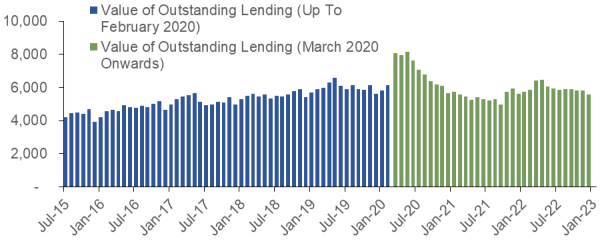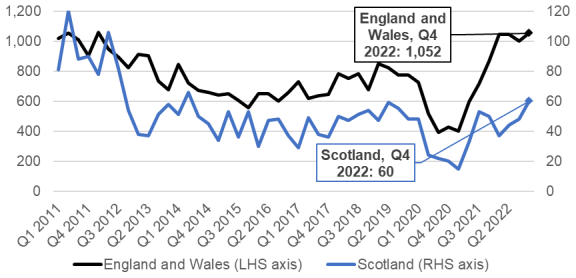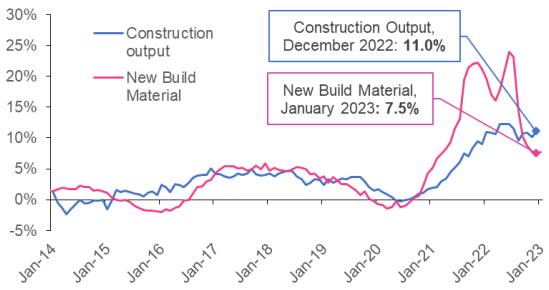Scottish Housing Market Review Q1 2023
Scottish housing market bulletins collating a range of statistics on house prices, housing market activity, cost and availability of finance and repossessions.
10. Lending to House Builders, Insolvencies & Construction Prices
Lending to House Builders
The value of loans outstanding to UK firms involved in the construction of domestic dwellings rose by £1.9bn from February to March 2020, an increase of nearly one-third (31%), as shown in Chart 10.1. The sudden increase likely reflected the need for credit to fund short-term liabilities owing to Covid-19 restrictions on construction activities and home moves, which had adversely affected firms' income. In addition, firms may have drawn down funds as a precaution, given the economic uncertainty.
From May 2020 to September 2021 the value of loans steadily decreased, falling below pre-covid levels. However, the value of loans seems to have returned to pre-pandemic levels, with the value of outstanding loans for 2022 so far 1.1% below the same period in 2019, despite the sharp increase in construction output prices (compare Chart 10.3).

Source: Bank of England
Insolvencies
Chart 10.2 shows that during the pandemic insolvencies of construction companies registered in Scotland fell from 48 in Q1 2020 to 15 in Q1 2021, with a similar proportional fall evident for England and Wales, likely due to the business support in place. However, with this support unwinding, new build construction output prices increasing (as shown in Chart 10.3) and cost of living pressures potentially impacting demand, insolvencies for construction companies registered in Scotland appear to be rising. There were 60 insolvencies in Q4 2022, an increase of 20.0% on Q4 2021 and relative to the 2017 – 2019 average for Q4 an increase of 30.4%. For construction companies registered in England and Wales insolvencies have increased to a larger extent, with an annual increase of 21.5% on Q4 2021, reaching 1,052. This is also 50.4% above the 2017 – 2019 average for Q4. This is the highest level of registered company insolvencies in England and Wales since Q1 2012 (1,057).

Source: The Insolvency Service
Construction Prices
Data from the ONS on the annual change in the construction output index price of new build housing (public and private), which covers the range of costs associated with building new public and private housing, shows an annual increase of 11.0% to December 2022 (Chart 10.3).
Data from BEIS (also illustrated in Chart 10.3) shows that the annual growth rate in the cost of construction materials used in new house building, which had reached as high as 24.0% in June 2022, has been moderating more recently, to stand at 7.7% in January 2023. The annual change has been driven in particular by insulating material (+40.9%), gravel, sand, clays and kaolin, including aggregate levy (28.5%) and cement (+24.8%). The largest annual decrease in prices came from imported sawn or planed wood (-15.8%), imported plywood (-8.2%) and particle board (‑7.0%).

Source: ONS and BEIS
Contact
Email: William.Ellison@gov.scot
There is a problem
Thanks for your feedback